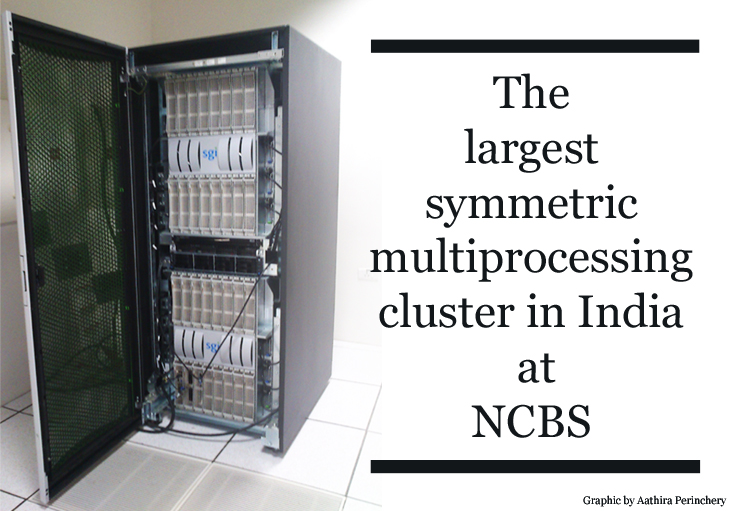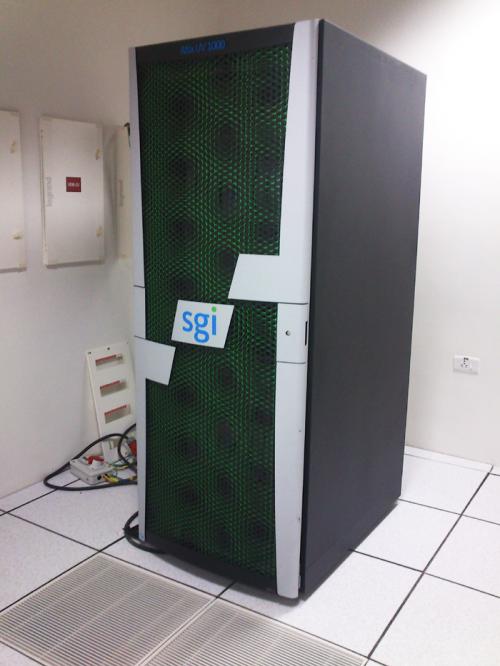Largest symmetric multiprocessing cluster in India at NCBS
NCBS installed a symmetric multiprocessing (SMP) cluster, the largest of its kind in India, on 28th December 2011. SMP clusters are used for high-performance computing, where calculations are carried out in parallel. The system at NCBS is a Silicon Graphics Inc. (SGI) Ultra Violet (UV) 1000 SMP cluster.
Supercomputers are used for computing processes that require intensive calculation. Supercomputers are of different kinds: an SMP cluster is one of them. In an SMP cluster, multiple processors are controlled by a single operating system (OS). While processors influence the speed of a system, cores are also integral: they are microprocessors that read and execute program instructions. Processors are made up of multiple cores, and the more the cores, the faster the system. Shared memory also makes the system more effective. A desktop with 1 processor and 2 cores, for instance, would work well for daily internet usage and working on Word documents, and would have around 16 MB of global shared memory. The SGI's UV1000 is the only system in the world which can be scaled to up to 2048 cores and 16 terabytes of global shared memory in a single Linux OS. These features make data processing faster.
Such supercomputers are commonly used in research that involves large amounts of data and simulations. At NCBS, the 352-core SGI UV1000 will find the same purpose. "The SGI UV1000 system will be used for genome sequencing applications with specific emphasis on the analysis of structure and function of proteins," says R. Sowdhamini, of the Biochemistry, Biophysics and Bioinformatics Group at NCBS. The Centre of Excellence Grant supported by India's Department of Biotechnology supplied funds for the cluster. The system will be used by Sowdhamini's group at NCBS, N. Srinivasan and Nagasuma Chandra's computing labs at the Indian Institute of Science and Satyajit Mayor's cell biology lab at NCBS. Srinivasan, Chandra and Mayor are co-investigators on this grant. The SMP cluster complements the recent virtual SMP cluster (where machines are grouped and software used to make them function like a single machine) that Sowdhamini's group still continues to use.
While the SGI UV1000 will hasten data processing, it's speed also depends on the software that is run on the system. "The software should also be able to use the core. For example, if we run Microsoft word on the same cluster, it might just work at the same speed as usual. So the applications that we are using are written for multiple processors," says Prasanta Kumar Baruah, the Systems Administrator (Engineer C) at NCBS.
NCBS's SGI UV1000 incorporates the latest technology in the field: it houses Intel's latest Xeon Westmere Processor. It has a combination of shared and distributed memory, and uses the world's fastest high-speed NUMA (Non-Uniform Memory Access) interconnect, with which processors can access their own memories faster.
When compared to a high-end desktop currently available in the market, Anu Nair, the Systems Administrator in this project, estimates that the SGI UV1000 will be a hundred times faster for highly-tuned applications and four times better if per core performance is considered. "It depends on the type of computing," Sowdhamini says. "Work in our lab involves a lot of input-output requests: the system will have to take an input file, do some computing and go on writing. So, this computer's shared memory will be very effective."
While the SGI UV1000 can scale upto 2048 cores, only 352 cores have been installed now. But each core, when programmed for parallelization (a process called hyperthreading), can be as effective as 2 cores. Are there plans to scale up the number of cores in future? "Yes, we would like to," says Sowdhamini.
Edited by Anil Ananthaswamy.


Comments
Post new comment